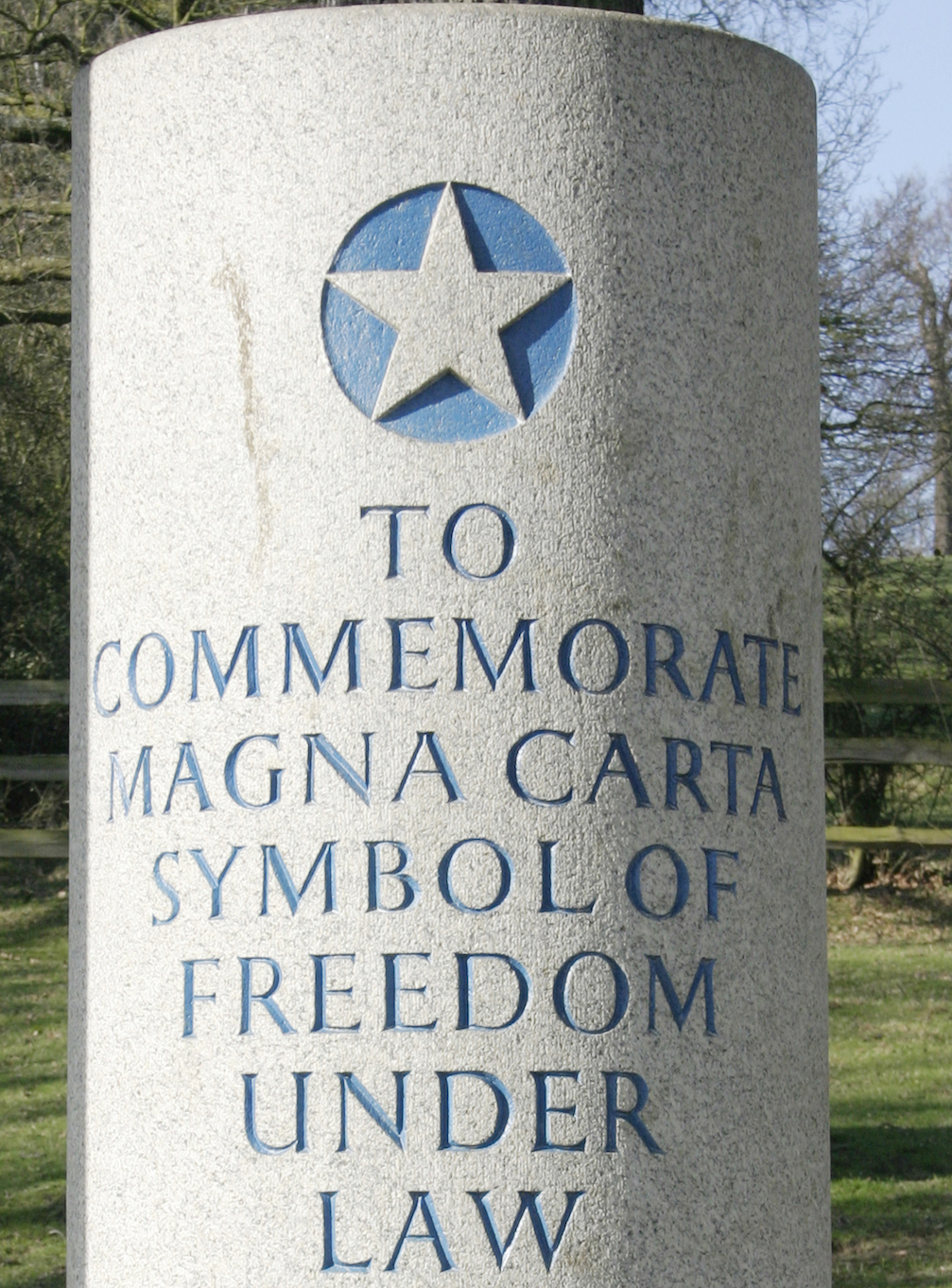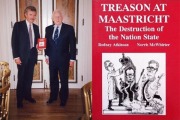By Torquil Dick-Erickson: Magna Carta crossed the oceans. In all the lands where English is spoken, its principles are known and recognised. But it never crossed the Channel.
Introduction (Rodney Atkinson)
One of the most extraordinary facts about British politics is the abysmal ignorance of constitutional matters in general and the great and world famous Magna Carta in particular. While talking of a “constitutional crisis” with Scottish nationalism and changes to the House of Lords, the great elephant in the room – the removal of constitutional and parliamentary power from the British people by the European Union – is studiously ignored! Magna Carta defended the legal rights of individuals against arbitrary rule by the King and defended the State against foreign domination. As result neither King John nor the Pope were pleased!
Here in this essay which appeared on the official Magna Carta website in this 800th anniversary year of the signing of the Charter at Runnymede on the Thames, Torquil Dick-Erikson who has been researching comparative criminal law in Italy for several decades shows how fundamentally alien (and for British values) unjust and dangerous the principles of continental law are. That they are now part of the over-arching European Union “corpus juris” to which every British citizen is exposed has been a matter of the gravest concern for many years.
http://magnacarta800th.com/articles/magna-carta-europe-yesterday-today
April 27, 2015
Magna Carta and Europe
By Torquil Dick-Erikson
The opinions expressed in the following are the views of the author, and do not represent the views of the Magna Carta 800th Anniversary Committee, or the Magna Carta Trust. (NB This was an attempt to belittle this article by the MCT!)
Magna Carta crossed the oceans. In all the lands where English is spoken, its principles are known and recognised. But it never crossed the Channel.
In 1215, in England the Barons were confronting King John; in Rome Pope Innocent III was setting up the machinery of the Holy Inquisition.
A major purpose of Magna Carta was to limit the powers of the King – the central State authority.
In contrast, the Inquisition expanded and deepened the power of the authorities over the individual. Not only actions, and words, but even thoughts, were scrutinised and, if “culpable”, punished.
In ancient Rome, an accuser faced a defendant, and the case was decided by a judge, independent from both. Under the Empire, the Emperor’s word became law. The dark ages saw more primitive forms of judgement (trial by ordeal, by combat…)
As analysed by the late, great, Italo Mereu, Professor of the History of Law at Ferrara University, in his painstakingly detailed history of the Inquisitorial system from the origins to the 1970s, “Sospettare e Punire” (“To suspect and to punish”), the Inquisition brought together the functions of prosecutor and investigator with that of the judge, in the new figure of the Inquisitor. The Inquisitor’s job was to identify, seize, and interrogate a suspect, in order to arrive at the “truth”. Or, it might be said, at the desired result.
The arbitrary powers of the inquisitor, and of his superiors, were clearly vast. The machinery of the Law became a tool for the ruler to ensure complete command and control over his subjects.
Clearly Magna Carta constituted a potent obstacle to such arbitrary exercise of power. In fact the Pope was furious when informed about what had happened at Runnymede, and wrote to the English bishops and abbots who had helped set it up telling them they had done something “abominable” and “illicit”.
The specific constraints on the power of the State provided by Magna Carta include the famous and much celebrated clauses 39 “No free man shall be…. punished… save by judgement of his peers and by the law of the land”, and 40 “To no-one shall we deny, delay, or sell justice”. Clause 39 in particular removed from rulers a crucial power of government, the power to decide who should be punished and who not. This power was placed in the hands of a jury of the defendant’s peers, thus laying a foundation stone of democracy, and a bulwark against arbitrary punishments.
For eight hundred years since then, the English and the continental criminal procedures have gone off in different directions.
The Inquisition ravaged the nations of continental Europe for centuries, persecuting and prosecuting witches, heretics, and…. scientists. Initially an ecclesiastical institution, its methods were adopted by secular rulers, as a means of suppressing opposition of any kind.
England alone escaped its grip. We fought off the Spanish Armada, which would have brought the Spanish Inquisition to our shores. Elisabeth I rejected the inquisitional method – “I will not make windows into men’s souls”. A sort of papal “fatwa” promised a fast track to heaven for any Catholic who murdered her. Yet she did not outlaw those who followed the old religion, though subjecting them to some constraints.
The power of Parliament grew and in the mid-seventeenth century prevailed over that of the king in the civil war. Parliamentary supremacy – representing ultimately the will of the people – was then firmly consolidated with the glorious – and bloodless – revolution of 1688-89.
Meanwhile across the channel absolutism held sway. The King of France famously proclaimed “I am the State”.
The French Revolution swept away much of the old order. The “rights of man” were proclaimed. Then soon Napoleon took over the helm of France, and his armies set about invading most of Europe to export his notion of the “rights of man”. His codes of law to this day underlie the legal systems used on the continent.
Some of the original thinkers of the enlightenment, like Voltaire, whose ideas helped spark the French revolution, had drawn inspiration from the very different system of government they had seen in England. But Napoleon did not adopt Magna Carta, nor its principles, in criminal procedure. He adopted and adapted the basic elements of the inquisition, redirecting it to serve not the Church, but the State.
In the traditional English system, the powers of jurisdiction governing the different parts of criminal procedure are attributed to different bodies. Essentially, the police, divided into 43 independent local constabularies, investigate a case; the magistrates (mostly non-lawyers, unpaid volunteers working part-time) sign arrest warrants, and then decide bail and committal to trial in public hearings; a barrister is hired to conduct the prosecution in court, where he or she faces another barrister hired by the defence; the judge presides over the proceedings in court deciding procedural disputes between the parties, and handing down the sentence after a guilty verdict. And crucially, the verdict is entirely in the hands of a jury of 12 ordinary citizens, voters selected by lot from the electoral register, peers of the defendant, just as was establsihed by Magna Carta so long ago.
The distribution of these powers into different hands provides essential checks and balances, not just between the legislative, executive and judicial functions, as famously prescribed by Montesquieu, but within the judicial function itself, on whose delicate balance depends the individual freedom of each and every citizen from arbitrary arrest and wrongful imprisonment. The use of legal violence on people’s bodies, by arrest and imprisonment, is an exclusive prerogative of the sovereign State in any society. Its arbitrary use is a prime tool of tyranny. This is why effective legal safeguards against misuse are so necessary. Here lies the genius of Magna Carta, which 800 years ago in England provided the first legal safeguards against such arbitrary misuse.
Compare and contrast with today’s Napoleonic-inquisitorial systems, where a career judiciary, whose members are State employees, comprises prosecutors and judges, but excludes defenders. The prosecutor is nowadays no longer the selfsame person as the judge, but they are both servants of the State (though they may sometimes be institutionally independent from political control), and they are close colleagues, who can work in tandem together on case after case. The judges may have been prosecutors during the course of their careers, but normally they will never have been defenders.
Under the Napoleonic-inquisitorial dispensation used in continental Europe, all these powers are placed in the collective hands of one brotherhood – the career judiciary.
In Italy, for example, criminal investigations, prosecutions, assessments of evidence, decisions on arrest, bail or remand, the direction of courtroom proceedings, judgements of guilt or innocence and sentencing are all under the exclusive control of members of the career judiciary (“magistratura” – not to be confused with the idea of an English “magistrate” for which there is no equivalent).
After a law degree, young law graduates face three career alternatives: attorney, notary, or the judiciary (“magistrato”). To become a judge, they must pass a stiff State exam (set and marked by existing members of the judiciary), and then they are in. After one year’s “apprenticeship”
(“uditorato”), they are assigned to a judicial office as a prosecutor/investigator or a judge, where they sit, pen in hand, empowered to order criminal investigations, arrests, bail, committals, etc. They are not trained in detective techniques, relying on their book knowledge of the law. But they direct the police (who may have such training) in the conduct of criminal investigations. It is said that this separation between competence and responsibility in criminal investigations explains why numbers of cases are not investigated as fruitfully as might be hoped.
Trial by Jury – that great heritage of Magna Carta – has no place in the Napoleonic-inquisitorial dispensation. Most cases are dealt with by professional judges alone. Very serious cases are heard by what might look like a jury of ordinary citizens chosen by lot. Actually, the verdict and the sentence are decided by a mixed panel of six lay “jury-people” and two professional career judges. They all go into the jury-room together, where the “judge’s summing-up” is delivered in secret. Although the six jury-people can outvote the two professionals, the latter obviously take a leading role in guiding the verdict. They also have other means of ensuring that what they consider a “perverse” verdict can be appealed against. There are no safeguards against double jeopardy – the prosecution are perfectly entitled to appeal against an acquittal, even if no fresh evidence has emerged.
Two other direct legacies of Magna Carta are clause 40 – “to no-one shall we delay justice”, and the not-so-often celebrated clause 38. The latter is worth quoting in the original: “Nullus ballivus ponat de cetero aliquem ad legem simplici loquela sua, sine testibus fidelibus ad hoc aductis” – “No judicial officer shall initiate legal proceedings against anyone on his own mere say-so, without reliable witnesses brought for that purpose”.
These provisions are ensured by Habeas Corpus. Under Habeas Corpus, a suspect if arrested must be brought into open court within hours (or at the very most, a few days), and there charged formally. And the charge must be based on enough hard evidence, already collected, to shew that there is a prima facie case to answer.
It is perhaps taken for granted in English-speaking countries that any proceedings must be based on evidence. Not so however on the continent. In Italy, for example, a person may be arrested on the orders of two members of the judiciary (one acts as “prosecutor-cum-investigator” and the other as “judge of the preliminary investigations”), at the outset, on mere suspicion based on clues (“indizi”). Hence the title of Professor Mereu’s book. The prisoner becomes a “person-under-investigation” (“indagato”), and can be kept in prison during the investigation, which can last months, before the authorities are ready to commit him. There is no right to any public hearing during this time. Within hours of arrest, the prisoner is interrogated by the two judges who ordered his arrest, in a secret hearing. He is assisted by his lawyer (or by a lawyer appointed by his interrogators if he cannot afford his own), and he can try to persuade them that they have got the wrong person, but he cannot see any evidence against him until much later.
All this directly violates clauses 38 and 40 of Magna Carta. Yet this is what happens to British subjects and others who are subjected to the European Arrest Warrant. Under the EAW no British court is allowed to ask to see any evidence of a prima facie case. Presumably the Parliamentarians who voted for this measure must have believed that the foreign judicial authority issuing the EAW would already have the necessary evidence, to be exhibited in a public hearing soon after extradition took place. Yet numbers of innocent Britons can testify that this is not the case. Famously, Andrew Symeou spent 11 months in a Greek prison before his first appearance in an open court hearing, where the case was dropped, owing to lack of any serious evidence.
It is thought that the European Convention of Human Rights offers adequate safeguards for the innocent. It does not. The ECHR makes no provision for Habeas Corpus, let alone Trial by Jury. Article 6 vouchsafes an appearance in a public hearing within a “reasonable” time after arrest, but does not specify what is “reasonable”. For us it is a matter of hours or at most days. In Europe it can be months or even longer.
Our forefathers, in their wisdom, laid down these safeguards for our freedom. Their words have rolled down eight centuries, to protect us. Yet today, we are abandoning them, for an illusion, based on wishful thinking.
This 800th year after Magna Carta is also the 200th anniversary of Waterloo. How ironic if Napoleon should have the last laugh after all.


















